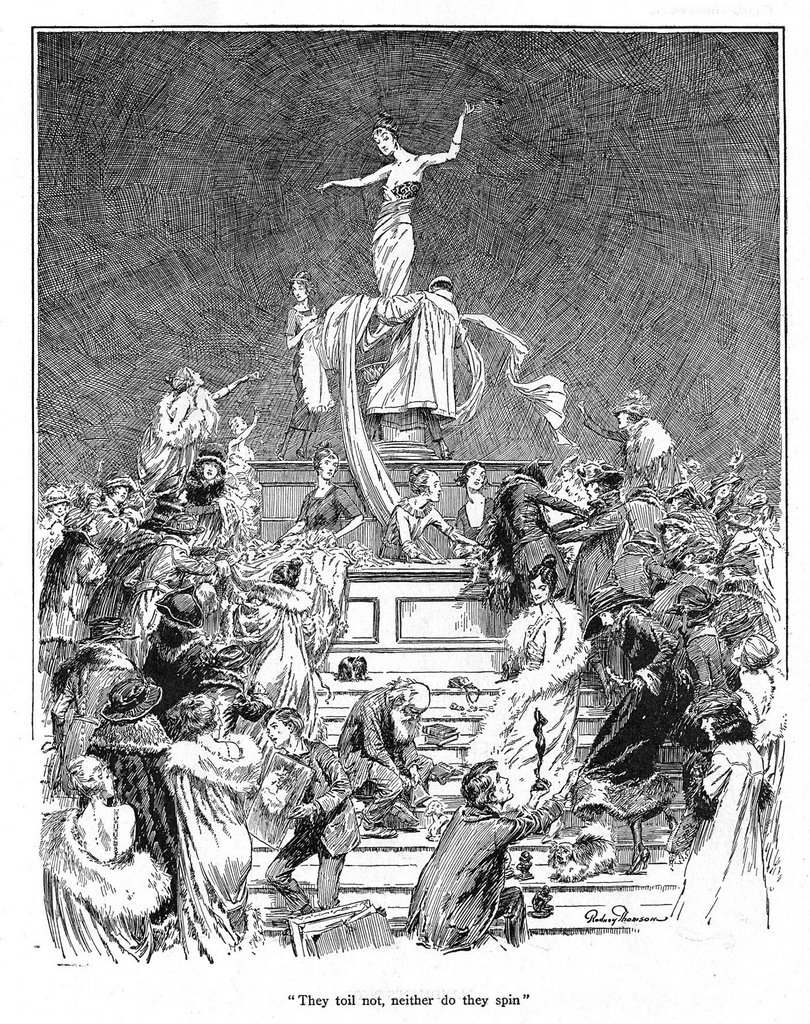RODNEY THOMSON
This topic spins off from the Reading Group discussion of
Detective Picture Stories #4. The Australian Panther provided strong evidence that Rodney Thomson, who drew the centerspread, was the same person as a magazine illustrator and printmaker who favored wildlife and Western themes. Though Internet info on Thomson proved scant, here's a brief sketch of his career compiled from the Panther's and my own research.
RODNEY F. THOMSON (1878-1941)
American visual artist Born in San Francisco. As a young man, he prospected for gold in California. He later studied art in San Francisco. He moved to New York in 1906, where he worked as an illustrator for magazines including
Life, Puck, and
Vanity Fair. The earliest illustration I could find is from
Life magazine. It dates from 1913 and ridicules suffragettes.

(Note: Orson Lowell was a well-known pen-and-ink illustrator from whom Thomson swiped the classical heads.)
About the same time he drew this cartoon, apparently from
Puck.
In 1915-1917 Thomson illustrated two or three (?) books for New York publishers. I found one online,
Battleground Adventures edited by Clifton Johnston (Houghton Mifflin 1915). He did many fine illustrations for this book. Most of them are available in large size at Wikimedia Commons. Here's a sample:

One art dealer says, "[Thomson] illustrated many Children's and Young Adults' books including
The Texas Flag Primer, The Open Road to Reading - Fifth Reader, The Field Fourth Reader, and
my Indian Boyhood by Luther Standing Bear."
Here is a fine illustration from 1920:

Thomson is best known today for his drypoints. He exhibited them at the Chicago Society of Etchers in 1928. The subjects were primarily wildlife and scenes from the American West. Here's an example:

Thomson exhibited a painting in a big show at the 1932 Los Angeles Olympics It was titled "Hurdles." I haven't found a reproduction.
In 1935 the Chicago Society of Etchers donated five Thomson prints to the Smithsonian American Art Museum. The link below shows all five. Click a thumbnail to go to that print's page. Then click on the picture there to see a beautiful (downloadable) high-resolution version.
https://americanart.si.edu/artist/rodney-thomson-4797In or about 1937 Thomson drew the centerspread for
Detective Picture Stories #4.
Rodney Thomson died in 1941.
I saved the best for last: a remarkable piece from circa 1915, "The Enlightenment Machine." Heritage sold the original last year for $1560. Satan, wearing his
If the Devil Could Talk outfit, sits at a typewriter with authors and artists instead of keys, causing them churn out "vulgar songs," "filthy plays," and "suggestive pictures."

There is a delicious irony here because about the same time Thomson drew this department header. Not only does it feature a gratuitously bare-breasted maiden, it was drawn for
Vanity Fair, a lifestyle magazine (1913-1937) which celebrated the very music, literature, and fashions the cartoon decries.

It still annoys me that Thomson's illustration signature and his comic book signature are so different. But I note that Thomson used different illustration signatures at different times. I guess he was just a guy who liked to change his signature occasionally.
In the Reading Group I speculated that Thomson may have drawn the
Detective Picture Stories text story illustration using a different style. After looking at so many Thomson illustrations I think this is pretty unlikely. Also the more I peer at the artist's initials the more they look like "RA" rather than "RT." It also appears that the date reads "31," not as I previously thought, "37" with a European-style crossed "7."



